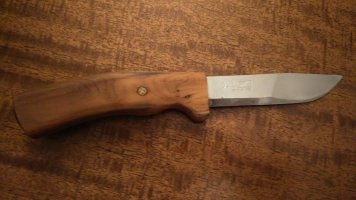I recently posted a few photos of a couple of cheap Hultafors knives I adapted at home in a thread I begana on another topic.
Just thought it might be an idea to start a thread where we could post ideas and photos of our home pimped knives?
Below are stainless and HD Hultafors knives that I adapted:
Both blades reground yo a deeper drop point.
The stainless handle seriously sandrd and filed down to fit my 6 year old's hand. The GK HD guard removed and handle properly sanded down as it was massive!
What have you kind folk done to your edged tools?
Just thought it might be an idea to start a thread where we could post ideas and photos of our home pimped knives?
Below are stainless and HD Hultafors knives that I adapted:
Both blades reground yo a deeper drop point.
The stainless handle seriously sandrd and filed down to fit my 6 year old's hand. The GK HD guard removed and handle properly sanded down as it was massive!
What have you kind folk done to your edged tools?






 unnamed
unnamed unnamed (1)
unnamed (1) 20190512_163037
20190512_163037


 Capture
Capture


